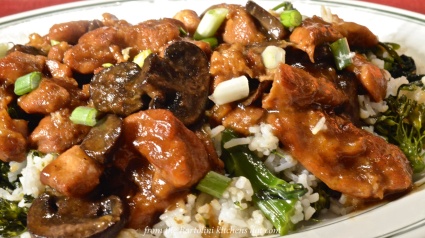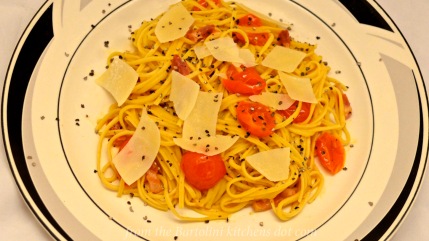Although I may not be posting many recipes that rely upon my new love, the spiralizer, I continue to us it frequently. In fact — hold on to your hats — I use it more often than I do my pasta machine. I know! I never would have thought such a thing possible. Yet, here I am with about 3/4 lb of homemade pasta in my pasta basket, where’s its been for just about 3 weeks now. 3 weeks!!! This would have been unthinkable just last summer and I have butternut squash to credit — or is it blame?
As much as I enjoy zucchini noodles, “zoodles”, their texture often leaves much to be desired, They can go from al dente to unappealingly soft in the blink of an eye. To avoid this, I often serve them raw, making more of a pasta salad than a dish of freshly cooked pasta. Not so with butternut squash. Roasting doesn’t affect these noodles’ “bite” but it does add flavor to the final dish. Best of all, these noodles can be served hot, making a number of dishes possible. Today’s recipe is one such dish.
As is the case with most seafood pasta dishes, this one is easy to prepare and you’ll find that roasted butternut squash compliments seafood quite well. Truth be told, I’ve a squash just waiting for me to return home from the fishmonger with more seafood. It won’t be long now.
* * *
* * *
Butternut Squash Noodles with Seafood Recipe
Ingredients
- 1 small butternut squash
- 2 tbsp olive oil, divided
- 2 oz (56 g) pancetta, chopped
- about 12 small clams — manila, littleneck, or cockles will do (See Notes)
- 1 clove garlic, minced or grated
- about 12 shrimp — no smaller than 41 to 50 ct/lb
- 2 tbsp breadcrumbs – omit if GF (See Notes)
- 2 tsp parsley per serving, chopped
- olive oil
- salt and pepper to taste
Directions
- Preheat oven to 400˚ F (195˚ C).
- Separate neck of squash from the bulb end that contains the seeds. Reserve the bulb for another use.
- Peel the squash before using a spiralizer to create spaghetti-like noodles.
- Place noodles on a baking sheet, season with salt and pepper, and sprinkle with 1 tablespoon olive oil. Place in oven and roast for 15 minutes.
- Combine breadcrumbs, parsley, and a bit of olive oil. Mix thoroughly. Place mixture in a small fry pan over medium heat. Cook until mixture is golden brown. Set aside.
- Begin heating remaining olive oil in a large frypan with a lid. Add the pancetta and begin to render its fat. Do not allow the pancetta to burn. It should be fully rendered about the time that the noodles have 5 minutes to go.
- Place the garlic and clams in the pan with the pancetta and cover. Sauté for 5 minutes before adding the shrimp to the pan. Cover the pan.
- After a minute or so, stir the frying pan’s contents and cover.
- Remove noodles from the oven and dump them into the pan with the seafood and pancetta. Stir to evenly coat everything with the pan juices.
- Continue to sauté until the clams and shrimp are fully cooked — no more than 2 minutes more.
- DISCARD ANY CLAMS THAT REMAIN UNOPENED.
- Remove to a serving platter and garnish with the toasted breadcrumbs created in Step 5.
- Serve immediately.
* * *
* * *
Notes
Use a brush reserved for food-prep to scrub all clams before cooking. Any that remain open after a thorough scrubbing should be discarded. Opinions vary as to whether to soak fresh clams in salt or fresh water to cause the clams to expel grit. Some feel that commercially harvested and shipped clams do not need such purging. If, however, your clams are bought directly from the fishermen or harvested yourself, they must be soaked for at least 30 minutes before scrubbing, changing the water midway through.
In Italian cooking, it is definitely not recommended to use grated Parmigiano or Pecorino cheese on a dish with most varieties of seafood. Very often, toasted breadcrumbs are substituted, just as I did above. Do you remember the stuffed calamari recipe I shared back in March? At the time, I suggested freezing the extra cooked breading mixture. They would make the perfect garnish for this dish, as well as a number of other pasta with seafood dishes. Being roasted already, all you need do is to warm them in a small frying pan. Use them as you would grated cheese, as a garnish just before serving.
I’ve seen recipes where squash noodles are boiled first, much like pasta, rather than roasted. I’ve yet to prepare them that way. If it ain’t broke …
My spiralizer is an attachment for a stand mixer. As such, it makes quick work of the “neck” of a butternut squash. Some may find this squash is too firm for their hand-cranked spiralizer. I’ve no experience with any of them and look forward to hearing from you in the Comments.
Of course, for a gluten-free version do not include the toasted breadcrumbs unless they’re GF. Garnish with chopped parsley instead.
* * *
It’s déjà vu all over again …
With September almost here, there’s no time like the present for frozen treats. If you’re like me and took advantage of the sour cherry season, stashing some of the red beauties in your freezer, well, now’s the time to set some of them free! Follow this LINK to learn how to use them to prepare frozen yogurt, as well as a tasty chocolate sauce to smother it. All that’s missing is the cherry on top!
* * *
Coming soon to a monitor near you …
General Tso’s Chicken
* * *


















